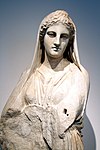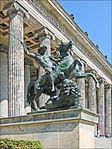Altes Museum
1830 establishments in PrussiaAltes MuseumAntikensammlung BerlinArt museums and galleries in BerlinArt museums established in 1830 ... and 6 more
Berlin State MuseumsClassicist architecture in GermanyHistory museums in GermanyMuseum IslandMuseums of ancient Greece in GermanyNeoclassical architecture in Berlin

The Altes Museum (English: Old Museum) is a listed building on the Museum Island in the historic centre of Berlin and part of the UNESCO World Heritage. Built from 1825 to 1830 by order of King Frederick William III of Prussia according to plans by Karl Friedrich Schinkel, it is considered as a major work of German Neoclassical architecture. It is surrounded by the Berlin Cathedral to the east, the Berlin Palace to the south and the Zeughaus to the west. Currently, the Altes Museum is home to the Antikensammlung and parts of the Münzkabinett.
Excerpt from the Wikipedia article Altes Museum (License: CC BY-SA 3.0, Authors, Images).Altes Museum
Am Lustgarten, Berlin Mitte
Geographical coordinates (GPS) Address Phone number Website External links Nearby Places Show on map
Geographical coordinates (GPS)
| Latitude | Longitude |
|---|---|
| N 52.519444444444 ° | E 13.398333333333 ° |
Address
Altes Museum
Am Lustgarten
10178 Berlin, Mitte
Germany
Open on Google Maps









